Willie Marlowe
Essays
PERSISTENCE OF DELIGHTS
Curated by E. Tornai Thyssen, at HallSpace, Boston, September 3-October 8, 2011
Essay by E. Tornai Thyssen, 2011
Willie Marlowe’s new work, paintings and collages on a small scale insist on a close, personal scrutiny. The Albany, NY-based artist is known for palpable and intense color embedded in glistening opaque paint that seems to shape itself into something magically alive. The conjured objects squirm with delight as they jump, roll, hang, and burrow into the ether of stage-like settings and interrogate illusion and reality. Improbable, cartoonish, sometimes farcical and sometimes deeply brooding, Marlowe’s imagery is born out of paint, the artist’s touch and a delightful sensuality ready to support personalized interpretations by each beholder.
Venetian glassmaking and Venice itself have inspired Marlowe in recent years as she to took up residency in the city of canals for several weeks at a time. Malleable glass behaves in ways similar to her handling of paint. Even the shapes she floats in Glass Furnace, Glass Rod and Venetian Balancing Act suggest the molten globules hanging at the tips of glassblowing rods. The shapes evoke a solid reality as they levitate above, below and behind one another, conjuring a comical, acrobatic performance.
Unusual for all the space it claims, Diamond Triangle II declares a new love for soft, dusty colors. The design within the shaped canvas is born of nestled rhomboids. Although constricting, the austere geometry is unable to pin the design onto a flat plane and the triangular elements oscillate like parts of a folded origami shield. The textured surfaces soak up light, and contrast with the smoothly painted stripes that enhance the effect. The cool geometry, the play with spatial perception, and the creamy humid colors also define a suite of small paintings like Rainwater Well and Alchemy with Glass. In these the shapes emerge amoeba-like from thin, colored veils that barely exist in space.
Marlowe’s images often divide into vertical segments serving as screens. Objects hover in mid-air in colors so intense their afterimage vibrates in white and black. Marlowe capitalizes on the polarity between the presence and absence of intense colors. She writes:
My paintings have always been about color, intense close valued color, neon color, deep color-texture—all color all the time I sometimes take a break and work in pure black and white. Not a painterly black with a special combination of color or a nuanced white, but Ivory Black and Titanium White straight from the tube. After a “time-out” to work exclusively in black and white, when I return to color, it feels new again and I find more unexpected possibilities.[Correspondence with author, July 31, 2011]
Dividing, sorting, and organizing is key to the black and white squares painted during the summer in a “time-out” period voided of color. Its twelve units can be arranged to aggregate into a totemic shape, or spread to invoke the pattern of a visual poem. Each square harbors triangles and trapezoids nestled next to one another, some with calligraphic marks and playful scribbling to reinforce the flow across the grid.
Some of Marlowe’s imagery ties closer to material facts. Several prints are digitally reworked diagrams of labyrinths surviving from centuries ago when they could have imaged the earthly journey toward the discovery of truth. Marlowe purchased the right to reproduce the diagrams in her own work in 2004.[Labyrinth diagrams originally published in Jeff Saward, Labyrinths and Mazes: A Complete Guide to Magical Paths of the World, New York: Lark books, 2003] Then she painted them with the electronic stylus dipped into the palette of colored pixels offered by Photoshop. The diagrams, themselves geometric reductions of the labyrinth patterns underfoot, become alive with the digital colors. The Eilenriede Turf Labyrinth still survives near the site of ancient Germanic cults. Marlowe awakens its enigmatic purpose and draws in into our present world of virtual realities. On the other hand the watercolor drawings of ancient rocks from County Kerry in Ireland connect the unique mark of hand skills to a single original. Painted in grey-green washes on handmade paper, the drawing reveals a yearning for the secrets of prehistory. Raised, transported, aligned and incised, the boulders were forced to structure ancient concepts of the universe.
Marlowe connects the history of humanity to her imagination and creative process. The organic membrane of Glass Wheel resembles the surface in Rock Art II, and the colored objects floated within evoke images of ancient DNA . As the wheel tumbles the ancient junk rattles and laughs within. Some fragments have jettisoned earlier to lead distinct lives and become Marlowe’s other paintings of singular delights.
THROUGH A GLASS, BRIGHTLY
Willie Marlowe's prismatic vision
Willie Marlowe's small paintings on paper delight us with their many-sided surprise. Her prismatic scenes deliver the same mind-jolt as today's super-microscopy, which transform a fiberblast cell or microphage into a fabulous chromatic tableau. They seem drawn from tropical gardens and Caribbean reefs, and the psychedelic spots the retinas record when our eyes are pressed shut. Surely there is calypso music in them, and sometimes the mysteries waves whisper to the sand at night. In their buoyant suspension and asymmetric balance, these tiny rectangles oscillate between reality and dream. It's nearly impossible to keep from smiling at their extravagant claims, or to feel their ripples of bliss. A saturated sensuality bursts from Willie Marlowe's art. Looking at it, we feel the same way.
Timothy Cahill
April 2003
Times Union Albany, NY
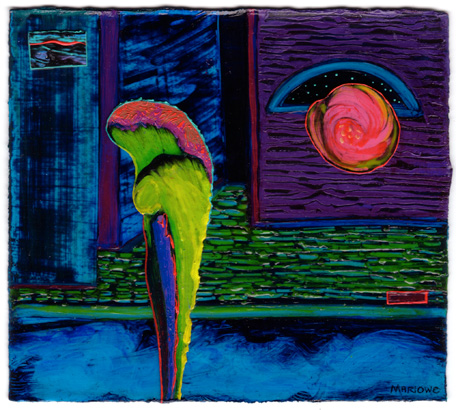
Mysterious Canal
collage, acrylic on paper
6" x 6.5"
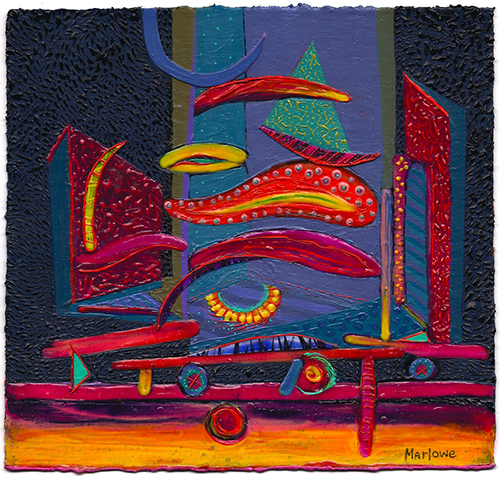
Venetian Balancing Act
acrylic on paper
6.5" x 7"
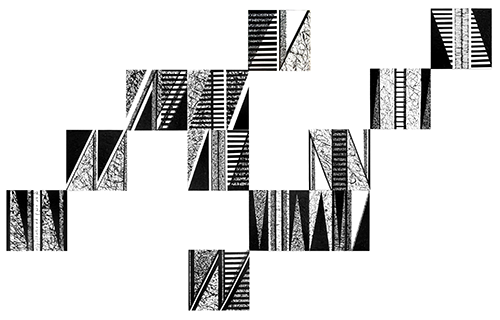
Keys
acrylic, paper, wood
12" x 12" each
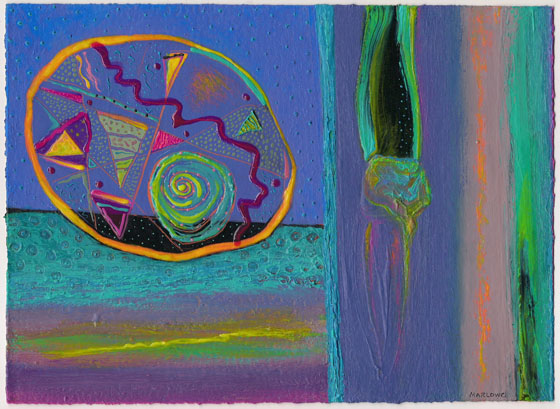
Glass Wheel
acrylic on paper
8" x 11"
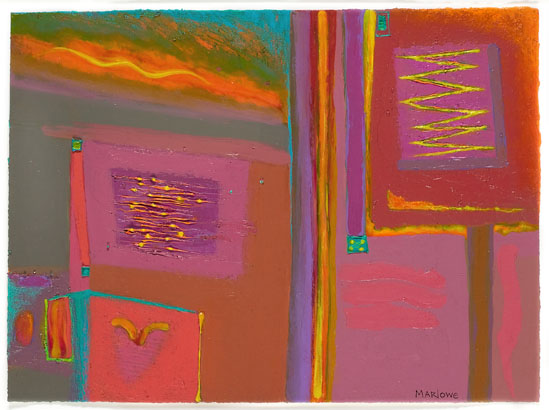
Box of Lights
acrylic on paper
7" x 9"
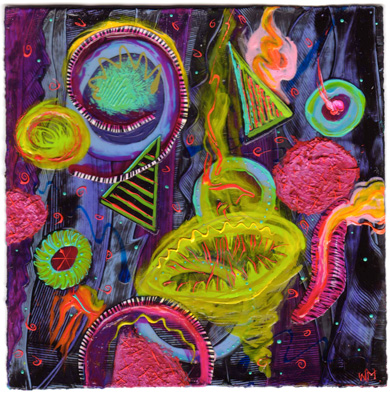
Nine Lives
acrylic
6" x 6"
Private Collection, North Carolina